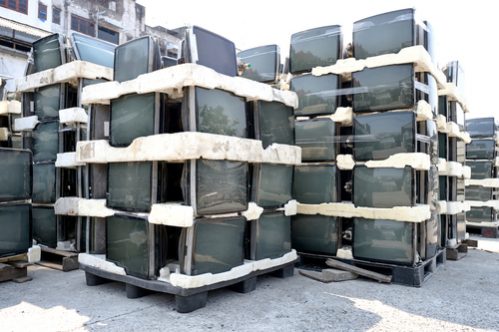
CalRecycle adjusts the amounts paid to recyclers to cover the average net costs of collecting and recycling covered products every year. | Anake Seenadee/Shutterstock
The California Department of Resources Recycling and Recovery has proposed increasing some payment rates for processors who participate in the state e-scrap program.
CalRecycle adjusts the amounts paid to e-scrap processors to cover the average net costs of collecting and recycling covered products every year. In 2024, CalRecycle increased the payment for recovery, which is collection and transportation for all covered e-scrap, from 35 to 40 cents per pound, and increased processing payments for CRTs from 63 to 73 cents per pound. It left the non-CRT payments at 75 cents per pound.
For the 2025 program year, CalRecycle proposed maintaining the recovery payment rate for all covered e-scrap at 40 cents per pound, while increasing the recycling portion of the combined recovery and recycling CRT payment rate from 73 cents to 79 cents per pound and the non-CRT rate from 75 cents to 76 cents per pound.
When combined with the recovery portion of the rate, the proposed totals are $1.19 per pound for CRT covered material – an increase of 60 cents – and $1.16 per pound for non-CRT material – an increase of 1 cent.
CalRecycle shared the proposed rates at an informal workshop on April 8 and at its April 22 monthly meeting. Per regulation, CalRecycle is required to file the proposed updates with the Office of Administrative Law on or before April 25 for them to become effective on July 1.
The agency evaluates payment rates on weighted average and also takes into account future unexpected costs, the presenters at the workshop noted.
2024 program details
Net cost reports for the 2024 program year were due March 1, and 300 reports were submitted, CalRecycle noted. Of those who submitted reports, 280 were collectors and 20 were recyclers.
Of the 20 recyclers, 16 supplied CRT recycling data and 20 supplied non-CRT data. Many report both, which explains the overlap in numbers.
CalRecycle sent program participants two reminders to submit by the deadline and then revoked three participants this year for failure to submit a net cost report.
After an analysis of as-reported 2024 data, the agency concluded that the “trend of widely varying costs continued” that year. CalRecycle then cleaned up the data to do a deeper analysis, excluding one CRT report, one non-CRT report and 57 recovery reports because the net costs were outliers, according to the presentation. An additional nine recovery reports were excluded due to errors.
Using that data set, CalRecycle reported that the industry average cost was 36 cents per pound in 2024. The current payment rate is 40 cents per pound, and 62% of collectors had a net cost at or below that rate.
Broken out by CRT, the average cost was 59 cents per pound, also below the 73-cent rate. About 80% of reports were below the set rate. The non-CRT average cost was 56 cents per pound, also below the set rate of 75 cents, and 79% of reports were below that set rate.
For CRT recyclers, the highest cost in 2024 was labor, with 34% of costs attributable to that category, followed by residual management at 27% and the cost to purchase covered e-scrap in excess of the recovery rate at 17%. The remaining percentages were transport (14%) and overhead (8%).
For non-CRT recyclers, the top three categories were the same, but in a slightly different order. Cost attributable to labor made up 46% of the overall total, followed by the cost to purchase covered e-scrap in excess of the recovery rate at 20% and residual management at 17%. The remaining percentages were transport (11%) and overhead (6%).
In addition, the practice of paying third-party handlers for covered material continued: Program participants paid $12.4 million to third parties in 2024, CalRecycle noted.